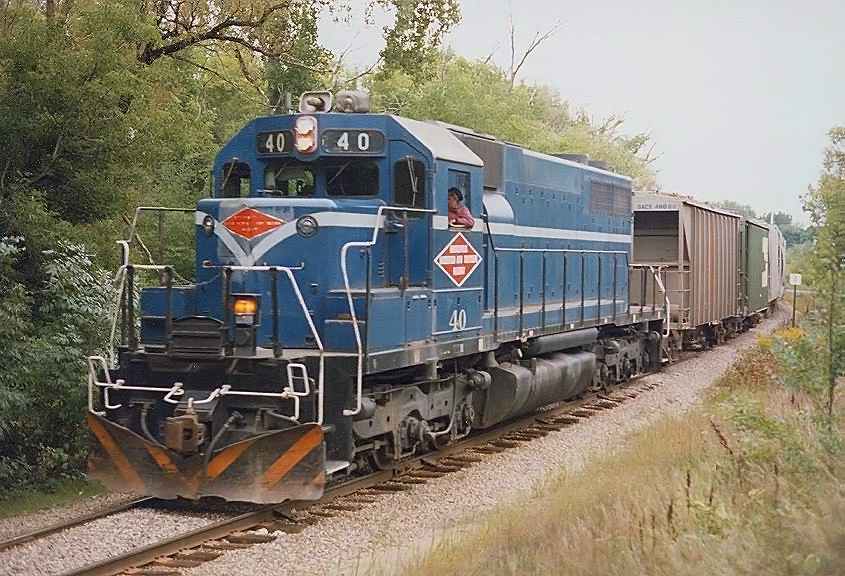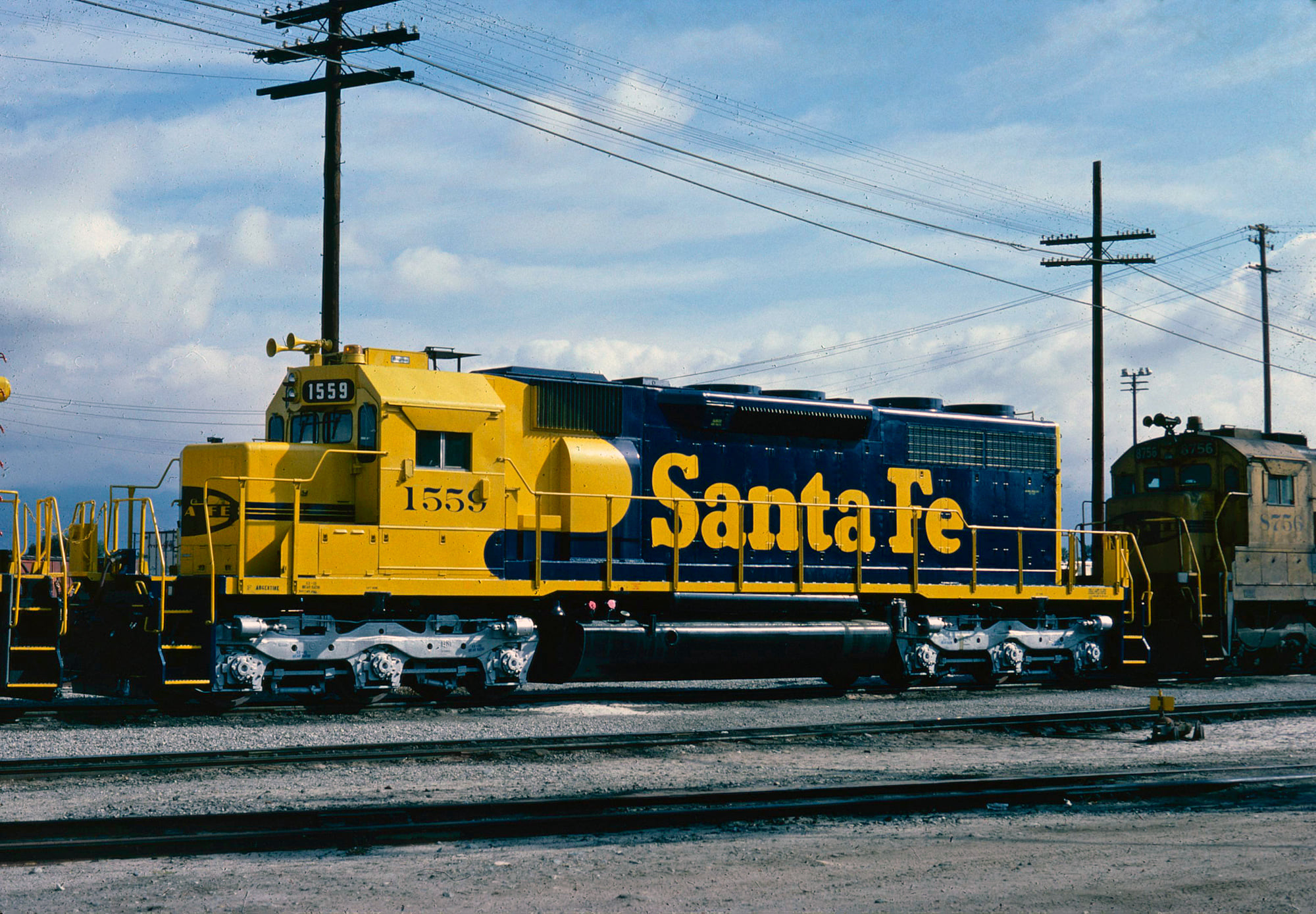EMD "SD39" and "SDL39" Locomotives: Data Sheet, Specs, Roster
Last revised: December 16, 2024
By: Adam Burns
Although the SD39 was produced for only a relatively short period, between 1968 and 1970, it holds a unique place in the early diesel era.
It represents a fascinating transition point, bridging the gap between the medium-horespowered designs and the burgeoning popularity of high-horsepower models for heavy freight service.
The model was part of EMD's new 645 line, which included in the C-C catalog the SD38, SD40, and SD45. The SD39 was the builder's mid-powered, turocharged variant utilizing only a 12-cylinder model 654E3 prime mover.
As Louis Marre notes in his book, "Diesel Locomotives: The First 50 Years, A Guide To Diesels Built Before 1972," most railroads shied away from turbocharged, mid-powered road-switchers due to their increased maintenance demands.
Ultimately, just 54 examples of the SD39 were sold. In addition, the Milwaukee Road acquired ten examples of the lightweight, SDL39 variant for branch line service.
 A pair of SD39s, #40-41, were the last new locomotives acquired by the Minneapolis, Northfield & Southern. Here, #40 returning to Glenwood Junction with the Soo Line transfer on September 16, 1982. Doug Kroll photo.
A pair of SD39s, #40-41, were the last new locomotives acquired by the Minneapolis, Northfield & Southern. Here, #40 returning to Glenwood Junction with the Soo Line transfer on September 16, 1982. Doug Kroll photo.Background and Development
The SD39 emerged during a time of significant change in the railroad industry. The demand for freight transportation was increasing, and railroads were under pressure to move larger and heavier trains more efficiently.
While four-axle locomotives, like EMD's popular GP40, were powerful, their relatively lightweight and B-B trucks limited their tractive effort, often leading to wheelslip under heavy load.
Six-axle models, with their additional driving wheels, offered a solution but came with increased maintenance costs and, in some cases, track wear issues.
EMD recognized an opportunity to offer a middle ground. They took the core components of their successful 3000-horsepower SD40, including its powerful 645E3 prime mover, and cataloged a de-rated 2300 horsepower variant.
The result was the SD39, a locomotive that offered nearly the same tractive effort while also being more fuel-efficient via a 12-cylinder power plant. The trade-off, of course, was lower horsepower.
Technical Specifications
The SD39 rode on EMD's standard Flexicoil trucks. This was the builder's popular C-C design and utilized on all of its cataloged six-axle models. This design, combined with its weight of approximately 360,000 pounds, provided excellent tractive effort, allowing it to handle heavy freight trains with ease.
Operational History
The SD39 found favor with just a handful of railroads including the Santa Fe, Southern Pacific, Illinois Terminal, and Minneapolis, Northfield & Southern. The SP wound up with the most - 26 examples - while AT&SF acquired another 20. The MN&S picked up 2 and IT's 8 rounded out the production total.
The SD39s were primarily assigned to heavy freight duties, hauling everything from coal and grain to intermodal containers and manufactured goods. They were particularly well-suited for challenging routes with steep grades and tight curves, where their increased tractive effort proved invaluable.
The MN&S and IT examples are perhaps the most interesting. Both roads carried an interurban heritage, most notably the latter system, and the SD39 was the largest power either ever owned. The IT's units wound up in the Norfolk & Western's fleet while the two acquired by MN&S were rolled into Soo Line's roster in 1982.
Legacy and Impact
While the SD39 was a capable and reliable locomotive, its production run was cut short by two factors; the previously noted increased maintenance costs and the arrival of EMD's Dash-2 series in 1972, which offered improved performance and fuel efficiency.
Many of the SD39s were eventually sold to smaller railroads or leasing companies, where they continued to operate for several more years. Some were even rebuilt and upgraded with more modern components, extending their service lives. Today, a handful of SD39s remain in operation, primarily in industrial or short-line service, serving as a testament to their rugged design and enduring legacy.
SDL39
While EMD never offered the SD39 in the Dash 2 line as Greg McDonnell notes in his book, "Locomotives: The Modern Diesel & Electric Reference (Second Edition)", the builder did construct 10 lightweight versions for the Milwaukee Road, which extended into the Dash 2 era.
The SDL39 was designed to replace its aging RSC2s for branch line service. At 55' 2" they were roughly 10 feet shorter than a standard SD model (including a smaller fuel tank) while also utilizing export trucks.
Data Sheet
| Attribute | Details | |
|---|---|---|
| Engine | 645E3 (12 cylinder) | |
| Bore & Stroke | 8 ½" X 10" | |
| RPM | 800 | |
| Main Generator | GM - D32 | |
| Alternator | GM - AR10 | |
| Horsepower | 2300 | |
| Gear Ratio | 59:15 | |
| Speed | 95 mph | |
| Trucks | 6-Wheel | |
| Configuration | C-C | |
| Weight | 360,000 lbs | |
| Traction Motors | GM D77 (6) | |
| Tractive Effort (Starting) | 90,000 lbs at 25% | |
| Tractive Effort (Continuous) | 82,100 lbs at 8 mph | |
| Multiple Unit Capability | Yes | |
| Dynamic Braking | Yes | |
| Auxiliary Generator | Delco A8102 | |
| Air Brake | Westinghouse (26L) | |
| Compressor | Gardner-Denver (WBO) | |
| Exterior Dimensions | ||
| Total Length | 65' 9" (SD39) | 55' 2" (SDL39) |
| Wheel Diameter | 40" | |
| Truck Wheel Base | 13' 7" | |
| Height to Top Engine Hood | 15' 2" | |
| Height to Top Cab | 15' 7 ½" | |
| Cab Width | 10' 4" | |
| Top of Walkway | 8' 9 ½" | |
| Walkway Width | 3' 8 ½" | |
| Engine Hood Width | 10' 3" | |
| Center Bolster | 40' 0" | |
| Center Front Truck to Front Pilot | 3' 9" | |
| Center Rear Truck to Rear Pilot | 3' 9" | |
| Distance between Truck Centers | 53' 7" | |
| Minimum Turning Radius | 57 degrees | |
| Fuel Capacity | 3200 Gallons | |
Production Rosters
SD39
| Serial Numbers | Completion Date(s) | Order Number | Owner | Road Numbers |
|---|---|---|---|---|
| 33998-34015 | 8/1968-10/1968 | 7110 | Southern Pacific | 5300-5317 |
| 34127-34128 | 10/1968 | 7119 | Minneapolis, Northfield & Southern | 40-41 |
| 34883-34888 | 5/1969-6/1969 | 7168 | Illinois Terminal | 2301-2306 |
| 35020-35031 | 5/1969 | 7176 | Santa Fe | 4000-4011 |
| 35032-35039 | 6/1969 | 7178 | Santa Fe | 4012-4019 |
| 35815-35822 | 4/1970 | 7219 | Southern Pacific | 5318-5325 |
SDL39
| Serial Numbers | Completion Date(s) | Order Number | Owner | Road Numbers |
|---|---|---|---|---|
| 34272-34276 | 3/1969 | 7135 | Milwaukee Road | 581-585 |
| 7345-1 thru 7345-5 | 11/1972 | 72648 | Milwaukee Road | 586-590 |
 Seen here is Santa Fe SD39u #1559 at San Bernardino, California; October 22, 1985. This unit was rebuilt from SD39 #4001 that same month. American-Rails.com collection.
Seen here is Santa Fe SD39u #1559 at San Bernardino, California; October 22, 1985. This unit was rebuilt from SD39 #4001 that same month. American-Rails.com collection.Conclusion
The SD39 may not have achieved the same level of fame or longevity as some of its counterparts, but it holds a significant place in diesel-electric locomotive history.
It represents a pivotal moment, showcasing the transition from four-axle to six-axle dominance in heavy freight service.
The SD39's legacy lives on in the lessons learned and technologies developed, paving the way for the even more capable locomotives that followed.
Recent Articles
-
Michigan Short Line Railroads: A Complete Guide
Mar 31, 25 09:49 AM
This information highlights the currently active short lines operating within the state of Michigan. -
Massachusetts Short Line Railroads: A Complete Guide
Mar 31, 25 09:46 AM
This article details the handful of short line railroads currently active within the state of Massachusetts. -
Maryland Short Line Railroads: A Complete Guide
Mar 31, 25 09:42 AM
Maryland, in spite of its small size, contains several active short line railroads, all of which are included within this article.